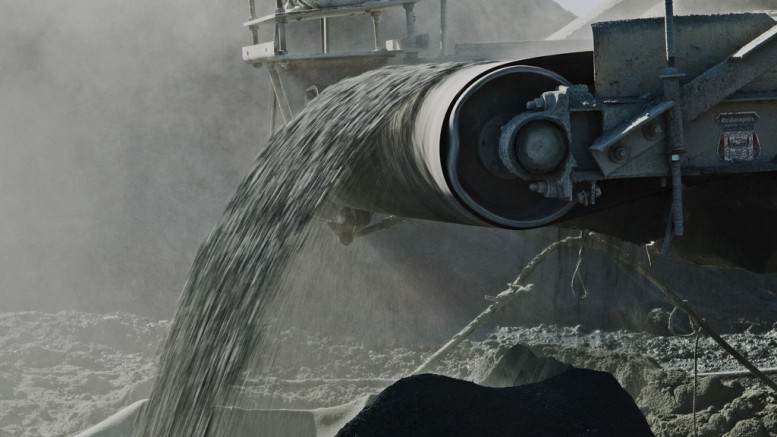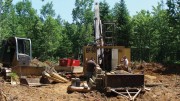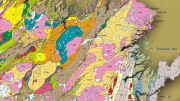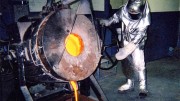Anaconda Mining (TSX: ANX) counts itself as the only pure-play gold producer in Atlantic Canada, and has increased its property control in the region about eighteenfold since 2012.
Its Pine Cove open-pit mine and mill — part of the company’s flagship Point Rousse project on Newfoundland’s Baie Verte peninsula — turned out 15,821 oz. in fiscal 2015 and 16,080 oz. gold in fiscal 2016. (The company’s fiscal year runs from June 1 to May 31.)
The 63 sq. km Point Rousse property also hosts the Stog’er Tight deposit, about 3.5 km from the Pine Cove mill with grades approximately double current production grades, and Argyle, a prospect Anaconda discovered northeast of Stog’er Tight, about 5.5 km from the mill. (Argyle is the first discovery in the area in the last 30 years, Anaconda says.)
In addition, Point Rousse has a third prospective area called Goldenville, an untested gold belt just kilometres north of the mill that has high-grade potential and an 8 km long horizon. Anaconda says Goldenville has a similar rock type to the Nugget Pond mine, which was mined in the late 1990s, and produced 166,000 oz. gold at grades of 11 grams gold. “Goldenville is the same type of rocks and the same type of setting, so we’ll drill that area hoping to find those types of grades,” President and CEO Dustin Angelo says. “We believe Goldenville is an analogue to Nugget Pond.”
This year, the company has expanded its footprint in the province 100 km southwest of Pine Cove in Newfoundland’s White Bay. Through option deals with Spruce Ridge Resources Ltd., Anaconda plans to acquire 100% of the Viking and Kramer properties. The Viking and Kramer properties combined encompass 40.3 sq. km and add to the 22 sq. km contiguous to Viking and Kramer that the company staked in January.
Angelo believes that the ounces of gold Anaconda amasses in White Bay — including what can be confirmed from the historic resource contained in Viking’s Thor deposit — can be processed at the company’s mill, and foresees a day that it will run two large gold-mining operations in the province.
“We’re pretty excited about the Viking project — it’s an area that could be one of the biggest growth areas for us,” Angelo says. “We say that because there is basically a large zone of anomalous rock in soil samples that cover 5.6 km in strike length, so it’s a pretty large anomalous system, and the Thor deposit, which sits in the middle of it, is where most of the drilling has been done … soil sampling in Newfoundland is a very good way of uncovering deposits, and if we’ve got 5.6 km of soil anomalies, there is a good chance we can find a much larger system — a much larger deposit.”
Viking’s historic resource measures 937,000 tonnes grading 2.09 grams gold per tonne for 63,000 oz. gold in the indicated category, and 350,000 tonnes grading 1.79 grams gold for 20,000 oz. in inferred. The core of the deposit — or 60% of the indicated resource — has grades greater than 3 grams gold per tonne, and the company says the deposit could be developed one day as an open-pit mine. Select drill intercepts at Viking have ranged from 2.8 grams gold over 54 metres to 5.42 grams gold over 23 metres and 33.74 grams gold over 5.8 metres.
At Point Rousse, the company has two National Instrument 43-101 compliant resources. When combined with Thor’s historic resource, Anaconda says the company has enough resources for four more years of production.
At the Pine Cove deposit, indicated resources stand at 1.5 million tonnes grading 1.61 grams gold for 77,390 oz. gold, and inferred resources add 220,700 tonnes averaging 1.59 grams gold for 11,260 oz. gold.
At Stog’er Tight, indicated resources measure 204,100 tonnes grading 3.59 grams gold for 23,540 oz. gold, and inferred resources tally 252,000 tonnes averaging 3.27 grams gold for 26,460 oz. gold.
Angelo hopes to double production at the company’s 1,200-tonne-per-day mill by finding more high-grade ounces across Anaconda’s sizeable land package in the province, and is embarking on a 17,000-metre drill program this year. About 10,000 of those metres will be at Point Rousse and 7,000 metres at Viking.
“Right now our grades range from 1.5 grams to 2 grams gold per tonne, and we’re looking to feed our mill with blended feed grade of 3 grams gold plus, so we’re looking to double production by delivering a higher grade to the mill, as opposed to significantly expanding mill capacity,” he says.
The drill program is designed to look for size and grade potential. “What we’re trying to do is double production without doubling the actual mill capacity — we want to double production at a relatively incremental capital cost, that’s the goal. If you can do that, you’re generating higher margins.”
The exploration results that the company has received since January suggest that anything is possible.
Last month, results of a 750-metre, 16-hole diamond drill program that focused on shallow areas no more than 40 metres from surface west and southwest of the Stog’er Tight deposit — known as the Gabbro and West zones — returned intercepts of 6.70 grams gold per tonne over 4 metres, including 8.85 grams over 3 metres; 3.72 grams gold over 4 metres and 2.27 grams gold over 3 metres; and 1.81 grams gold over six metres.
The company designed the program to test the hypothesis that the Gabbro and West zones join below surface, and find out if surface mineralization at the West zone continues down-dip, and extends from the Stog’er Tight deposit.
The drill program determined that West and Gabbro are separate mineralization zones, and both continue at depth. The Gabbro zone dips shallowly to the north beneath the West zone and is within 20 metres of surface. Both zones are the folded extensions of Stog’er Tight, which extended the strike length by 100 metres for a total of 500 metres.
In addition, the company interpreted the drill results as indicating that there are other showings throughout the Stog’er Tight project area that may represent fold repetition of the deposit.
Earlier this year, the company reported results from trenching and sampling at the Argyle prospect, which suggest not only that there are geological similarities to Pine Cove and Stog’er Tight, but there is an initial 300-metre strike length of alteration and mineralization.
The program at Argyle consisted of excavating overburden along four trenches over 181 metres and 68 metres of channel sampling the exposed bedrock. Three of the four trenches tested the eastern part of the prospect where it was previously constrained by a single trench. A fourth trench tested the western limits of the prospect. Sample results include 1.89 grams gold over 10 metres; 1.31 grams gold over 11 metres; and 3.75 grams gold over 16 metres.
Finally, results from drilling the southern margins of the Pine Cove deposit to 75 metres deep — in an area known as Pine Cove Pond (not in the current mine plan) — also yielded positive results. Highlights include 2.11 grams gold over 10.5 metres; 2.68 grams gold over 15.9 metres; and 3.16 grams gold over 5.5 metres.
“The Pine Cove deposit and adjacent areas remain one of our highest priorities in our goal of outlining future production and growth within the Point Rousse project,” Angelo said. “Discovering near-surface mineralization at these grades that is open for expansion at the southern margins of the mine is a positive signal that this part of the Pine Cove deposit could be expanded and potentially included in our mine plan.”
Angelo says the company will be cashed up to complete this year’s 17,000-metre drill program and won’t need to raise more money any time soon. It recently unveiled a $2-million flow-through financing with Red Cloud Klondike Strike, and another agreement with the Royal Bank of Canada for a $1-million revolving line of credit, in addition to a $500,000 revolving equipment lease line of credit.
It also has proceeds from its mining operation at Pine Cove.
“We have cash flow from the operating mine, so we generate our own cash,” he says. “We raised additional funding because we wanted to accelerate our exploration.
“Some of the areas we’re looking at are so close to the mill that we don’t need to be 1 million oz., if we can find smaller deposits that are anywhere from 150,000 to 250,000 oz.,” he adds. “If we find multiples of those we’ll have a significant amount of ounces right in our backyard.”
Another thing to remember, he says, is that unlike many juniors doing exploration, Anaconda already benefits from existing roads, proximity to tidewater, and available power. “All of the infrastructure is already in place,” he says. “We don’t have to build a mill or roads, or find another workforce. It’s all there.”





Be the first to comment on "Anaconda touts high-grade upside at Pine Cove"